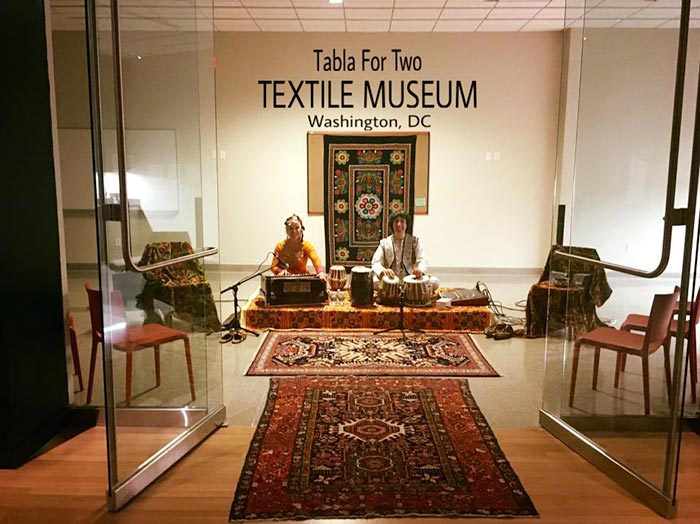Stepping into a museum can be an exhilarating experience, transporting you to different times and places. But what if that journey was narrated through the threads of history, woven from diverse cultures and artistic expressions? The Textile Museum in Washington DC offers precisely that—a captivating exploration of textiles from around the world, reflecting their role in daily life, rituals, and artistic expression.

Image: www.tablafortwo.com
Walking into the museum’s hallowed halls, you’re immediately greeted by the vibrant colors and intricate patterns of textiles that adorn the walls and display cases. The air hums with the stories these fabrics tell— stories of ancient weavers in Egypt, skilled artisans in Asia, and innovative designers in the Americas. Each piece whispers tales of tradition, innovation, and the enduring human connection to textiles.
Celebrating the Art & History of Fabrics
A Tapestry of Cultures
The Textile Museum boasts a diverse collection spanning centuries and continents. From the delicate silk brocades of China to the vibrant kente cloths of Ghana, the museum showcases the rich diversity of textile traditions worldwide. Each piece tells a story—an intricate weave of cultural heritage, artistic skill, and social history.
The museum’s collection is organized by geographical region, highlighting the unique techniques, materials, and motifs that define each textile tradition. You can trace the evolution of weaving, embroidery, and dyeing across cultures, marveling at the ancient techniques that have remained relevant for centuries. For example, the museum’s collection of Andean textiles reveals the complex symbolism woven into these fabrics, representing the intricate relationship between humans and their environment.
A Journey Through Time
Beyond geographical regions, the museum explores the evolution of textiles through time, demonstrating how fabrics have played a central role in shaping human civilization. From the early use of textiles for clothing and shelter to their evolving role as symbols of status, wealth, and cultural identity, the museum showcases the profound impact of textiles on society.
The museum’s collection includes examples of ancient Egyptian linen, luxurious Roman silk, and intricate Persian carpets, each piece illuminating the historical context in which it was created. Through these examples, you can trace the development of textile-making techniques and understand how fabrics have reflected social and political changes over time.

Image: www.pinterest.com
Modern Innovations & Contemporary Crafts
The Textile Museum isn’t just a repository of the past; it also celebrates contemporary textile arts. The museum features exhibitions that showcase the work of contemporary artists who push the boundaries of traditional textile techniques, blending traditional craft with modern technology and artistic expression. These exhibitions demonstrate how textiles are continuously evolving, adapting to new materials, technologies, and artistic concepts.
The museum also hosts workshops and events that encourage visitors to engage with the creative power of textiles. These hands-on experiences provide opportunities to learn new techniques, explore different materials, and create their own textiles, fostering a deeper appreciation for the art and craft of textile production.
Tips for Your Textile Museum Visit:
To make the most of your visit, consider these tips:
- Begin your exploration with the museum’s permanent collection, which offers a comprehensive overview of textile traditions worldwide.
- Take a guided tour to gain deeper insights into the museum’s collection and the stories behind each textile.
- Attend a workshop or event to engage with the hands-on aspects of textile making.
- Browse the museum store, where you can find unique textiles, books on textile history, and handcrafted items inspired by the museum’s collection.
Investing time in learning about the history of textiles can enrich your appreciation for the world around you. Understanding how fabrics have shaped our history and cultures allows for a deeper understanding of our present and future.
FAQ:
- What is the best way to get to the Textile Museum?
The Textile Museum is located at 2320 S Street, NW in Washington, DC. It is easily accessible by public transportation, with multiple Metro stations within walking distance. You can also reach the museum by car, with nearby parking options. - What are the museum’s hours of operation?
The Textile Museum is open Tuesday through Sunday from 10:00 AM to 5:00 PM. Closed Mondays and major holidays. - How much does admission cost?
Admission is free for visitors 17 and under. Adults can purchase tickets online or at the door for $10. - Are there any special exhibits on display?
The museum routinely hosts temporary exhibitions showcasing diverse themes and contemporary textile artists. Check their website for current exhibitions and scheduled events.
Textile Museum In Washington Dc
Unlocking the World of Textiles
The Textile Museum in Washington, DC, invites you on an enriching exploration of the diverse world of textiles. From the intricate patterns of ancient fabrics to the innovative artistry of contemporary artists, the museum showcases the captivating journey of textiles through history and across cultures.
Are you interested in learning more about the art and history of textiles? Have you visited the Textile Museum in Washington DC?
We’d love to hear your stories and experiences in the comments below!





